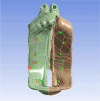The three-dimensional finite element model of unilateral complete cleft lip and palate and mechanical analysis of the oral surfaces
- PMID: 40042749
- PMCID: PMC11883061
- DOI: 10.1186/s40902-024-00452-7
The three-dimensional finite element model of unilateral complete cleft lip and palate and mechanical analysis of the oral surfaces
Abstract
Background: Cleft palate is a prevalent oral and maxillofacial malformation that requires complex surgical interventions. In cleft palate repair, managing flap tension is critical to avoid complications such as flap rupture and impaired healing. Additionally, excessive flap movement can compromise blood supply, affecting postoperative outcomes. A thorough understanding of these biomechanical factors is crucial for surgical success.
Methods: A three-dimensional finite element model was developed using CT scan data to simulate the biomechanical behavior of the cleft palate under surgical conditions. The model was constructed and analyzed using ANSYS Workbench and related software, incorporating material properties of bone, mucosa, and muscle. Stress and deformation distributions were calculated to evaluate surgical incision points and flap movement.
Results: The model identified critical areas of high tension and movement along the surgical incisions on both oral and nasal surfaces. The maximum deformation observed was 3.9885 mm, with stress concentration points along the suture lines and flap edges. The results highlighted specific regions prone to mechanical stress, which are crucial for optimizing surgical strategies.
Conclusion: This study demonstrates the potential of a 3D finite element model in predicting mechanical responses of the cleft palate during surgical repair. The findings provide surgeons with valuable insights for improving incision placement, flap design, and suturing techniques to minimize tension and enhance healing. This personalized approach could significantly improve surgical outcomes and reduce postoperative complications in cleft palate repair.
Keywords: CT image; Oral and nasal surface mechanics; Three-dimensional finite element model analysis; Unilateral complete cleft palate.
© 2025. The Author(s).
Conflict of interest statement
Declarations. Ethics approval and consent to participate: Not applicable. Consent for publication: All authors consented to publication. Competing interests: The authors declare that they have no competing interests.
Figures





References
-
- Chaudhari PK, Kharbanda OP, Chaudhry R, Pandey RM, Chauhan S, Bansal K et al (2021) Factors affecting high caries risk in children with and without cleft lip and/or palate: a cross-sectional study. Cleft Palate Craniofac J 58(9):1150–1159 - PubMed
-
- Van Dyck J, Cadenas de Llano-Pérula M, Willems G, Verdonck A (2019) Dental development in cleft lip and palate patients: A systematic review. Forensic Sci Int 300:63–74 - PubMed
-
- Shaye D, Liu CC, Tollefson TT (2015) Cleft lip and palate: an evidence-based review. Facial Plast Surg Clin North Am 23(3):357–372 - PubMed
Grants and funding
LinkOut - more resources
Full Text Sources
